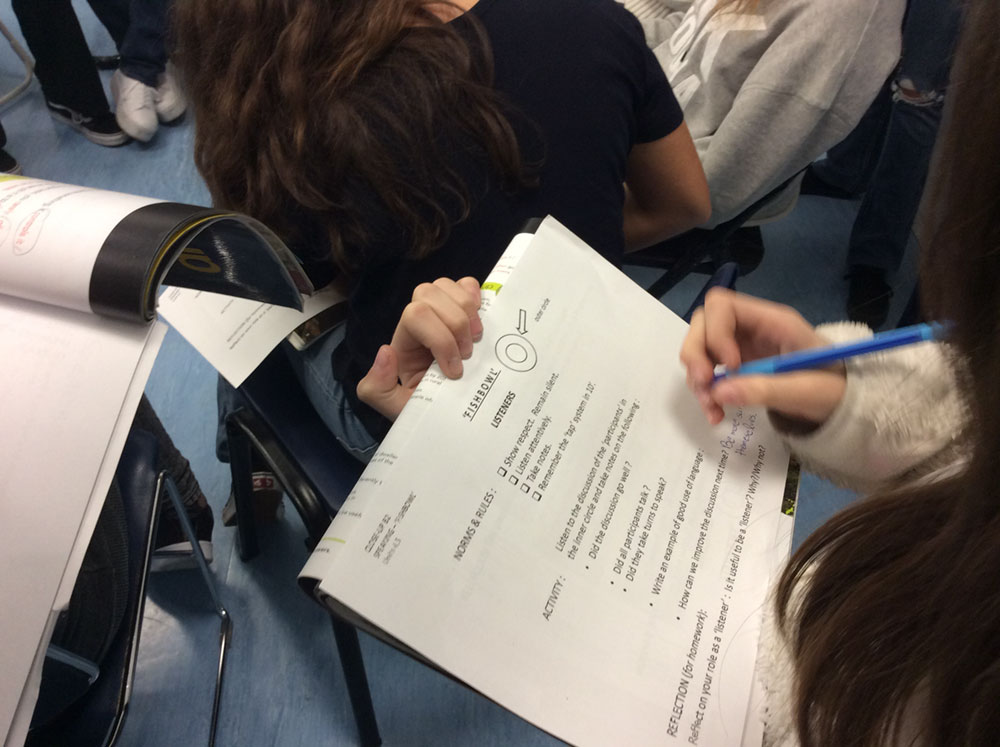Everything started with four short reading passages in a B2 level Student’s book which I am working on this year.
The topic of the short texts was ‘Globalisation’ and my 13-year-old students in their first year of junior high school, did not really know what the term ‘Globalisation’ means and some mistaken views of it were heard in class.
So, I realized that in order to make sure all my students would be able to accomplish the Reading tasks of that particular unit in a way that it would make sense with them, I had to 1) adjust the content, 2) adjust the process and 3) adjust the end-product of the teaching process.
By Maria Limniati, MA in Language Studies, Lancaster University, Teacher of English
It became clear then to me that I had to re-establish substantial learning goals. The first thing I wanted my students to grasp was the meaning of the term ‘Globalisation’ which would help the transition to the second learning goal that of helping each individual student read and comprehend, make the necessary connections and understand better the advantages and disadvantages of ‘Globalisation’ as presented in those short passages, that would, in turn, lead to a 3rd learning goal which was giving support to each student to produce work using newly acquired knowledge.
Putting my thoughts and ideas together having those clear goals in mind, I started planning and organizing my differentiated instruction. So, the more I thought about my teaching, the more I realized that although the content I had to teach was ‘Reading’, I would have to involve all 4 skills, listening, speaking, reading and writing, so as to maintain motivation and improve student outcomes.
As I see it, the implementation of differentiated instruction, integrating the 4 skills is a ‘different’ way to give students input in a receptive skill (listening/reading) and expect them to produce output in a productive skill. (speaking/writing)
Therefore, I am now going to present briefly what I did with the ‘Globalisation’ passages and give a few ideas for differentiated instruction :
Adjusting the content :
- Students watched a 4-minute video (https://yhoo.it/2IRREGn)
introducing the concept of ‘globalisation’ and presenting its pros and cons. At this stage new vocabulary was given and listening and speaking skills were involved as the students after watching the video twice they had to reproduce and recycle the information they had heard. - The subsequent Reading task (the 4 short passages) based on the same topic were now facilitated by the previous activity which was used as support to performance in this 2nd stage.
Adjusting the end-product using productive skills (Writing and Speaking):
- (www.pixton.com) Students were presented with a ‘new’ to them Web.02 tool, the pixton comics educational platform. The activity at production stage is for students to create their own comic strip or storyboard depicting some advantages and/or disadvantages of globalization. Some end-products of this activity are presented here.
Apart from being a fun, creative and interesting task for the students it can show pretty well how they have mastered what they have been taught already. - The ‘Fishbowl’ activity. I left my favourite for the end!
Actually, ‘fishbowl’ was the last thing I decided to do with the students so as to sum up all previous activities and tasks. The activity requires a sitting re-arrangement, which sounds rather interesting for the kinesthetic types. Two circles are formed, an inner circle (with chairs) and an outer circle. In the inner circle, the fishbowl, the ‘participants’ had to discuss ‘globalisation’ through multiple perspectives representing viewpoints of different social categories (e.g. young, old, factory worker, industrialist).
In the outer circle the ‘listeners’ listened attentively and took notes about what went well, what had to be improved etc. The activity lasted 10 minutes and the students switched roles and had another 10-minute session followed by a subsequent ‘Debriefing’ part where the students reflected, both in a class discussion and in writing, about their performance, the quality of the discussion, what could be improved, what they liked and how they felt being ‘participants’ and ‘listeners’, and it seems that the particular activity worked equally well for all students.
Summing up, through this differentiated instruction the students maximized their possibilities for success which was obvious in the creation of comics but I feel it was more during the ‘fishbowl’ activity where the students had a rigorous discussion where they produced topic –related language, expressed views and ideas, recycled and revised what they had learnt and showed accountability for their own learning.
As for us, teachers, with all our big and small successes and failures, feeling the vibes of a differentiated classroom as opposed to a traditional one, is something that we owe ourselves and it is surely something that can keep us going through this demanding and ‘rewarding’ profession. •
